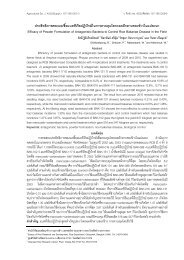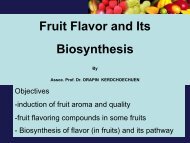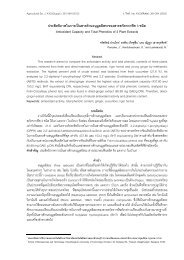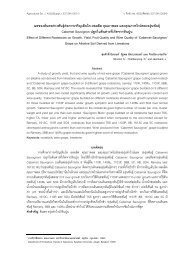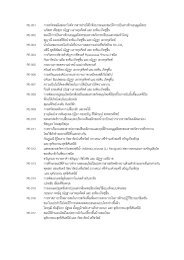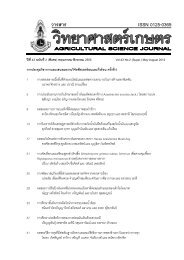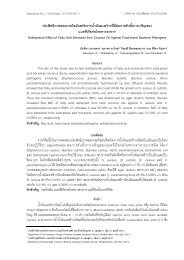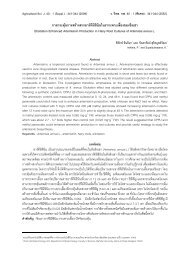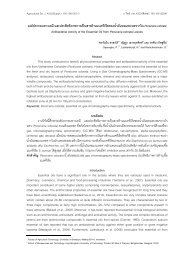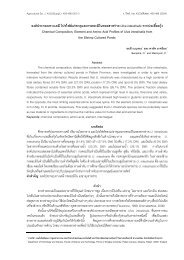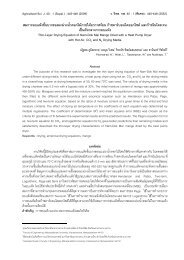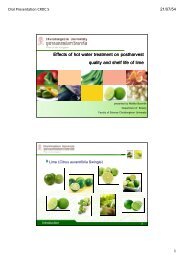à¸à¸§à¸²à¸¡ à¹à¸à¸µà¹à¸¢à¸§à¸à¹à¸à¸à¸à¸à¸ antioxidant enzymes à¹à¸¥à¸° lipid ... - CRDC
à¸à¸§à¸²à¸¡ à¹à¸à¸µà¹à¸¢à¸§à¸à¹à¸à¸à¸à¸à¸ antioxidant enzymes à¹à¸¥à¸° lipid ... - CRDC
à¸à¸§à¸²à¸¡ à¹à¸à¸µà¹à¸¢à¸§à¸à¹à¸à¸à¸à¸à¸ antioxidant enzymes à¹à¸¥à¸° lipid ... - CRDC
Create successful ePaper yourself
Turn your PDF publications into a flip-book with our unique Google optimized e-Paper software.
Agricultural Sci. J. 41(3/1)(Suppl.): 553-556 (2010) ว. วิทย์. กษ. 40(3/1)(พิเศษ): 553-556 (2553)<br />
ความเกี ่ยวข้องของ <strong>antioxidant</strong> <strong>enzymes</strong> และ <strong>lipid</strong> peroxidation กับความแข็งแรงของเมล็ดพันธุ ์ข้าวโพด<br />
พันธุ ์สุวรรณ 5 ที ่ hydropriming<br />
Involvement of Antioxidant Enzymes and Lipid Peroxidation on Seed Vigour of Maize Seeds cv. Suwan 5<br />
Through Hydropriming<br />
ภภัสสร วัฒนกุลภาคิน 1 คิน เลย์ คู1 กนก รัตนะกนกชัย 1 ภาณุมาศ ฤทธิชัย 2 และ ทรงศิลป์ พจน์ชนะชัย 3 *<br />
Wattanakulpakin, P. 1 , Kyu, K.L. 1 , Ratanakhanokchai, K. 1 , Ritthichai, P. 2 and Photchanachai, S. 3 *<br />
Abstract<br />
Maize seeds (Zea mays L.) ‘Suwan 5’ from Nation Corn and Sorghum Research Center (NCSRC) was<br />
hydroprimed for 6-18 h at 25C. Hydropriming did not effect to seed germination compared to the control seeds.<br />
Hydropriming for 6 and 12 h improved the seed vigour as indicated by a higher germination percentage after<br />
seed ageing at 42C and 100% RH for 96 h. However, the longer hydropriming times by 18 h significantly<br />
reduced seed vigour compared to the seeds primed for 6 and 12 h. While, the declined malondialdehyde (MDA)<br />
content in seeds primed for 18 h was significantly different to the other treatments. Hydropriming for 12 and 18 h<br />
decreased the superoxide dismutase (SOD) activity compared to the control seeds. Ascobate (APX) activity was<br />
independent by the different priming treatments. The experiment suggests that the seed vigour of maize primed<br />
seeds do not involve with <strong>lipid</strong> peroxidation but declining seed vigour may be related to a reduction of SOD<br />
activity.<br />
Keywords: seed vigour, priming, <strong>antioxidant</strong> <strong>enzymes</strong>, <strong>lipid</strong> peroxidation<br />
บทคัดย่อ<br />
เมล็ดพันธุ ์ข้าวโพดพันธุ ์สุวรรณ 5 จากสถานีวิจัยข้าวโพดและข้าวฟ่ างแห่งชาติ ที่ hydropriming เป็ นเวลา 6-18 ชม. ที่<br />
อุณหภูมิ 25C พบว่า hydropriming ไม่มีผลต่อความงอกของเมล็ดพันธุ ์เมื่อเปรียบเทียบกับชุดควบคุม แต่พบว่าเมล็ดพันธุ ์ที่<br />
hydropriming เป็ นเวลา 6 และ 12 ชม. มีความแข็งแรงสูงขึ ้นเมื่อทดสอบโดยการเร่งอายุที่ 42C ความชื ้นสัมพัทธ์ 100% เป็ น<br />
เวลา 96 ชม. แต่ hydropriming เป็ นเวลา 18 ชม. ท าให้ความแข็งแรงของเมล็ดพันธุ ์ลดลงอย่างมีนัยส าคัญกับเมล็ดที่<br />
hydropriming เป็ นเวลา 6 และ 12 ชม. และพบว่าปริมาณ malondialdehyde (MDA) ลดลงอย่างมีนัยส าคัญทางสถิติเมื่อ<br />
เปรียบเทียบกับชุดการทดลองอื่นๆ ในขณะที่กิจกรรมของ superoxide dismutase (SOD) ของเมล็ดข้าวโพดที่ hydropriming<br />
เป็ นเวลา 12 และ 18 ชม. ลดลงเมื่อเปรียบเทียบกับชุดควบคุม แต่ hydropriming ไม่มีผลต่อกิจกรรมของ ascobate<br />
peroxidase (APX) จากผลการทดลองพบว่าความแข็งแรงของเมล็ดพันธุ ์ข้าวโพดที่ hydropriming ไม่มีความเกี่ยวข้องกับ <strong>lipid</strong><br />
peroxidation แต่การลดลงของความแข็งแรงอาจมีความสัมพันธ์กับการลดลงของกิจกรรม SOD<br />
ค าส าคัญ: ความแข็งแรงของเมล็ดพันธุ ์, priming, <strong>antioxidant</strong> <strong>enzymes</strong>, <strong>lipid</strong> peroxidation<br />
1<br />
สายวิชาเทคโนโลยีชีวเคมี คณะทรัพยากรชีวภาพและเทคโนโลยี ม.เทคโนโลยีพระจอมเกล้าธนบุรี 49 ม.8 ถ.เทียนทะเล 25 แขวงท่าข้าม เขตบางขุนเทียน กทม.10150<br />
1<br />
Division of Biochemical Technology, School of Bioresources and Technology, King Mongkut’s University of Technology Thonburi, 49 Moo. 8,Tientalay 25 Rd.,<br />
Thakham, Bangkhuntien, Bangkok 10150, Thailand.<br />
2<br />
ภาควิชาเทคโนโลยีการเกษตร คณะวิทยาศาสตร์และเทคโนโลยี ม.ธรรมศาสตร์ ศูนย์รังสิต 99 ถ.พหลโยธิน อ.คลองหลวง จ.ปทุมธานี 12121<br />
2<br />
Department of Agricultural Technology, Faculty of Science and Technolog, Thammasat University Rangsit Center, 99 Paholyothin Rd., Klongluang, Patumtani<br />
12121, Thailand.<br />
3<br />
หลักสูตรเทคโนโลยีหลังการเก็บเกี ่ยว คณะทรัพยากรชีวภาพและเทคโนโลยี ม.เทคโนโลยีพระจอมเกล้าธนบุรี 49 ม.8 ถ.เทียนทะเล 25 แขวงท่าข้าม เขตบางขุน<br />
เทียน กทม.10150<br />
3<br />
Postharvest Programme, School of Bioresources and Technology, King Mongkut’s University of Technology Thonburi, 49 Moo. 8, Tientalay 25 Rd., Thakham,<br />
Bangkhuntien, Bangkok 10150, Thailand.
554 ปี ที่ 41 ฉบับที่ 3/1 (พิเศษ) กันยายน-ธันวาคม 2553 ว. วิทยาศาสตร์เกษตร<br />
Introduction<br />
Priming has been widely used to improve seed germination and vigour in many crop species. The advantages<br />
of priming, improved seed vigour, are reported to involve with the repair and build up of nucleic acids, the<br />
increased synthesis of proteins as well as the repair of membranes (McDonald, 1999). Priming also enhances the<br />
activities of scavenging <strong>enzymes</strong> and reduces <strong>lipid</strong> peroxidation, indicating by MDA content, result to the increase<br />
in seed germination and vigour in purple coneflower (Chiu et al., 2006) and bitter gourd seeds (Wang et al.,<br />
2003). However, improper priming processes, due to the unfavorable imbibitions and re-drying steps, generate<br />
reactive oxygen species (ROS) such as superoxide radical (O 2 - ), hydrogen peroxide (H 2 O 2 ) and hydroxyl radical<br />
(Leprince et al., 1994). ROS can initiate injurious degradation causing <strong>lipid</strong> peroxidation, membrane deterioration,<br />
protein and nucleic acids degradation leading to reduce seed vigour and cell death (McDonald, 1999).The poorer<br />
longevity of primed sh-2 sweet corn seeds than unprimed seeds was found (Chang and Sung, 1998). The effect of<br />
priming on seed vigour and biochemical mechanisms is depended on seed species and priming methods<br />
(McDonald, 1999). The aim of this research was to study the involvement of <strong>antioxidant</strong> <strong>enzymes</strong> and <strong>lipid</strong><br />
peroxidation on seed vigour of maize seeds cv. Suwan 5 through the variations of hydropriming times.<br />
Material and Methods<br />
Maize seeds (Zea mays L.) ‘Suwan 5’, harvested in December, 2008, was purchased from Nation Corn and<br />
Sorghum Research Center (NCSRC). The seeds were hydroprimed by placing them on metal wire sieve container<br />
laying on distilled water surface for 6-18 h at 25C. Thereafter, the imbibed seeds were immediately dried at 40C<br />
for 24 h to reduce the moisture content down to initial moisture content. The unprimed seeds were used as a<br />
control sample. Moisture content (%), germination (%), vigour test (accelerated ageing test at 42C and 100%RH<br />
for 96 h) of primed and unprimed seeds was investigated followed by ISTA rule (2007). The <strong>lipid</strong> peroxidation was<br />
explained in term of malondialdehyde (MDA) content in the seeds (Tamagnone et al., 1998). Superoxide<br />
dismutase (SOD) (Beauchamp and Fridovish, 1971) and ascobate peroxidase (APX) (Nakano and Asada, 1987)<br />
were analyzed. The experiment was arranged as a completely randomized design (CRD) with four replications.<br />
Data were subjected to analysis of variance (ANOVA) and significant differences among means were determined<br />
by Duncan’s New Multiple Range Test at P
Germination(%) and<br />
Germination after AA-test (%)<br />
MDA content (mol/g DW)<br />
ว. วิทยาศาสตร์เกษตร ปี ที่ 41 ฉบับที่ 3/1 (พิเศษ) กันยายน-ธันวาคม 2553 555<br />
activity was independent by the different hydropriming times (Table 1). The experiment suggests that the reduced<br />
seed vigour by hydropriming for 18 h may relate to the decline in SOD activity but these two <strong>enzymes</strong> did not<br />
involve with the increased seed vigour.<br />
The reduction of SOD activity may lead to accumulate MDA content in the seeds priming for longer period. The<br />
comprehensive understanding of the relationship between MDA content and seed vigour by longer hydropriming<br />
was investigated. Germination of primed seeds (24 and 30 h) decreased significantly compared to control<br />
samples, nevertheless, the MDA content remained unchanged (Fig. 1). Thus, the reduction of vigour of primed<br />
maize seed is not related to <strong>lipid</strong> peroxidation. Unlike our results, the decrease of the germination rate as well as<br />
seed vigour correlated to an increase of the MDA content found in sunflower (Corbineau et al., 2002) and cotton<br />
seeds (Goel et al., 2003). Non-enzymatic <strong>antioxidant</strong>s or protein degradation may contribute to the reduction of<br />
the maize primed seed vigour.<br />
Table 1 Moisture content (%MC), germination (%G), germination after accelerated ageing (%AA), MDA content<br />
and the activities of SOD and APX in maize seeds ‘Suwan 5’ hydroprimed for 6-18 h at 25C.<br />
Priming MC G AA MDA SOD APX<br />
times (h) (%) (%) (%) mol/g DW unit/kernel unit/mg protein<br />
0<br />
6<br />
11.2<br />
11.5<br />
96ab<br />
99a<br />
84b<br />
90a<br />
6.68a<br />
6.27a<br />
5.099ab<br />
5.388a<br />
13.01<br />
13.11<br />
12 11.5 98a 92a 6.05a 4.427b 9.29<br />
18 11.4 92b 80b 3.29b 3.130c 11.29<br />
The different mean in column separated by small letters indicate statistical significance according to the Duncan’s New Multiple<br />
Range Test (P < 0.05)<br />
.<br />
100<br />
80<br />
60<br />
40<br />
20<br />
0<br />
G<br />
AA<br />
MDA<br />
6 3<br />
Hydropriming times (h)<br />
8<br />
7<br />
6<br />
5<br />
4<br />
3<br />
2<br />
1<br />
0<br />
Figure 1 %Germination (G),<br />
%germination after accelerated ageing<br />
(AA) and MDA content in maize seeds<br />
‘Suwan 5’ hydroprimed for 6-30 h at<br />
25C. Error bars represent ±S.E.<br />
Summary<br />
Hydropriming for 6 and 12 improved maize seed vigour. The high seed vigour did not associate with MDA<br />
content (<strong>lipid</strong> peroxidation) and the activity of SOD and APX. Hydropriming for 18 h reduced seed vigour which<br />
may relate to decline in SOD activity. In this study, however, <strong>lipid</strong> peroxidation did not involve with primed maize<br />
seed vigour.<br />
Acknowledgement<br />
This research was supported by a grant under the program Strategic Scholarships for Frontier Research<br />
Network for the Ph.D. Thai Doctoral degree Program from the Commission on Higher Education, Thailand.
556 554 ปี ที่ 41 ฉบับที่ 3/1 (พิเศษ) กันยายน-ธันวาคม 2553 ว. วิทยาศาสตร์เกษตร<br />
Literature cited<br />
Beauchamp, C.O. and Fridovich, I., 1971, Superoxide Dismutase: Improved Assays and an Assay Applicable to<br />
Acrylamide Gels, Analytical Biochemistry, 44: 276-287.<br />
Berno Bernal-Lugo, I. and Leopold, A.C., 1995, Seed Stability during Storage: Raffinose Content and Seed<br />
Glassy State, Seed Science Research, 5: 75–80.<br />
Chiu, K.Y., Chen, C.L. and Sung, J.M., 2003, Partial Vacuum Storage Iimproves the Longevity of Primed sh-2<br />
Sweet Corn Seeds, Scientia Horticulturae, 98: 99–111.<br />
Chiu, K.Y., Chuang, S.J. and Sung, J.M., 2006, Both Anti-oxidation and Lipid-carbohydrate Conversion<br />
Enhancements are Involved in Priming-improved Emergence of Echinacea purpurea Seeds that Differ in<br />
Size, Scientia Horticulturae, 108: 220–226.<br />
Chang, S.M. and Sung, J.M., 1998, Deteriorative Changes in Primed Sweet Corn Seeds During Storage, Seed<br />
Science Technology, 26: 613–626.<br />
Corbineau, F., Gay-Mathieu, C., Vinel, D. and Come, D., 2002, Decrease in Sunflower (Helianthus annuus) Seed<br />
Viability Caused by High Temperature as Related to Energy Metabolism, Membrane Damage and Lipid<br />
Composition, Physiologia Plantarum, 116: 489–496.<br />
El-Araby, M.M. and Hegazi, A.Z., 2004, Responses of Tomato Seeds to Hydro- and Osmo-priming, and Possible<br />
Relations of Some Antioxidant Enzymes and Endogenous Polyamine Fractions, Egyptian Journal of Biology,<br />
6: 81-93.<br />
Goel, A., Goe, A.K. and Sheoran, I.S., 2003, Changes in Oxidative Stress Enzymes During Artificial Aging in<br />
Cotton (Gossypium hirsutum L.) Seeds, Journal of Plant Physiology, 160: 1093–1100.<br />
ISTA, 2007, International Rules for Seed Testing Edition, Published by The International Seed Testing<br />
Association, Switzerland.<br />
Leprince, O., Atherton, N.M., Deltour, R. and Hendry, G.A.F., 1994, The Involvement of Respiration in Free<br />
Fadical Processes During Loss of Desiccation Tolerance in Germinating Zea mays L. An Electron<br />
Paramagnetic Resonance Study, Plant Physiology, 104: 1333–1339.<br />
McDonald, M.B., 1999, Seed Deterioration: Physiology, Repair and Assessment, Seed Science Technology, 27,<br />
177–237.<br />
Nakano, Y. and Asada, K., 1987, Purification of Ascorbate Peroxidase in Spinach Chloroplasts: Its Inactivation in<br />
Ascorbatedepleted Medium and Reactivation by Monodehydroascorbate Radical, Plant and Cell<br />
Physiology, 28: 131–140.<br />
Qun, S., Jim-hua, W. and Bao-qi, S., 2007, Advances on Seed Vigour Physiological and Genetic Mechanisms.<br />
Agricultural Sciences in China, 6: 1060-1066.<br />
Tamagnone, L., Merida, A., Stacey, N., Plaskitt, K., Parr, A., Chang, C.F., Lynn, D., Dow, J.M., Roberts, K. and<br />
Martin, C., 1998, Inhibition of Phenolic Acid Metabolism Results in Precocious Cell Death and Altered Cell<br />
Morphology in Leaves of Transgenic Tobacco Plants, Plant Cell, 10: 1801–1816.<br />
Wang, H.Y., Chen, C.L. and Sung, J.M., 2003, Both Warm Water Soaking and Solid Priming Treatments Enhance<br />
Antioxidation of Bitter Gourd Seeds Germinated at Sub-optimal Temperature, Seed Science Technology,<br />
31: 47–56.<br />
Yeh, Y.M., Chiu, K.Y., Chen, C.L. and Sung, J.M., 2005, Partial Vacuum Extends the Longevity of Primed Bitter<br />
Gourd Seeds by Enhancing Their Anti-oxidative Activities During Storage, Scientia Horticulturae, 104: 101–<br />
112.



